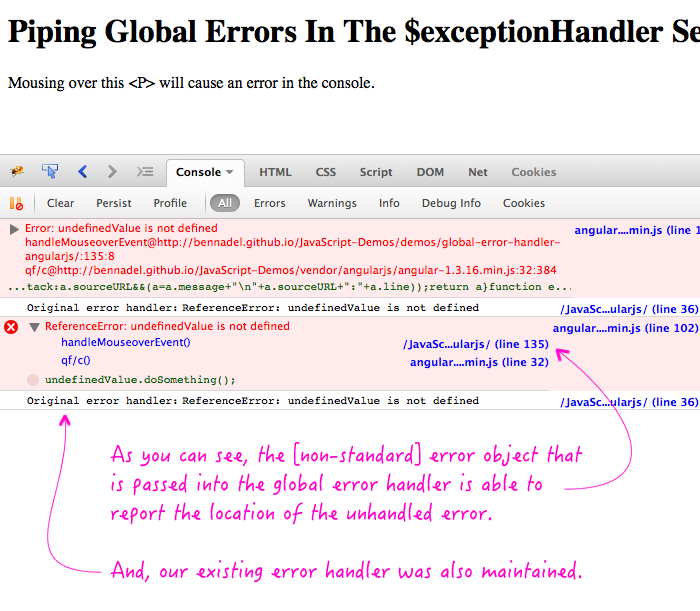Piping Global Errors Into The $exceptionHandler Service In AngularJS
Out of the box, AngularJS has excellent error handling in so much as that everything that AngularJS "knowns about" is executed inside of a try/catch block. These managed errors are handed off to the $exceptionHandler service, where your application may or may not process them further. But, errors that happen outside of an AngularJS workflow, such as those that happen in a jQuery plugin, go off into the void. As such, I wanted to see if I could catch those unhandled errors and pipe them into the core $exceptionHandler service.
Run this demo in my JavaScript Demos project on GitHub.
The global error handler - window.onerror - is, from what I have read, a rather old and outdated feature and is not standardized across browsers. As such, if you are using a "professional" 3rd-party script that handles client-side errors, you are going to be better off just letting that script manage the errors. This exploration attempts to manage errors in the absence of such a script (though I do my best to not overwrite any existing window.onerror functionality).
Because we are trying to handle errors that happen outside of the AngularJS workflow, I think this functionality is best configured in a "run block" that executes after the AngularJS application is bootstrapped. You might be tempted to try to "decorate" the $window service during the configuration phase (my first attempt). However, you will run into a circular dependency-injection reference between $window, $exceptionHandler, and $log.
In the following code, I attach a new $window.onerror function which turns around and sends the error object to the $exceptionHandler service. The assumption with this approach is that the $exceptionHandler service is either being overridden or decorated by something else in the AngularJS application.
<!doctype html>
<html ng-app="Demo">
<head>
<meta charset="utf-8" />
<title>
Piping Global Errors Into The $exceptionHandler Service In AngularJS
</title>
</head>
<body>
<h1>
Piping Global Errors Into The $exceptionHandler Service In AngularJS
</h1>
<p bn-test>
Mousing over this <P> will cause an error in the console.
</p>
<!-- Load scripts. -->
<script type="text/javascript" src="../../vendor/angularjs/angular-1.3.16.min.js"></script>
<script type="text/javascript">
// Create an application module for our demo.
var app = angular.module( "Demo", [] );
// --------------------------------------------------------------------------- //
// --------------------------------------------------------------------------- //
// I am here to make sure our error handler doesn't override any existing error.
window.onerror = function( message ) {
console.log( "Original error handler:", message );
return( true );
};
// When the app is bootstrapped, we want to wire into the global error handler
// so that we can pass "external errors" (ie, errors that happen outside the
// AngularJS work-flows) off to the $exceptionHandler where they may or may not
// be further processed.
// --
// CAUTION: The global error handler is, apparently, a pile of inconsistent junk
// in different browsers. If you are using a 3rd-party script that handles global
// errors, it would probably be best to just let that script manage this stuff
// since it will likely do a better job. This demo assumes that you are NOT using
// something of that nature.
app.run(
function addGlobalErrorHandler( $window, $exceptionHandler ) {
// Get a reference to the original error handler, if it exists, so we
// don't overwrite any error-handling functionality that might be added
// by a 3rd-party script.
var originalErrorHandler = $window.onerror;
// If there is no existing global error handler, let's define a mock one
// so that our custom error handler code can be handled uniformly.
if ( ! originalErrorHandler ) {
originalErrorHandler = function mockHandler() {
// By returning True, we prevent the browser's default error handler.
return( true );
};
}
// Define our custom error handler that will pipe errors into the core
// $exceptionHandler service (where they may be further processed).
// --
// NOTE: Only message, fileName, and lineNumber are standardized.
// columnNumber and error are not standardized values and will not be
// present in all browsers. That said, they appear to work in all of the
// browsers that "matter".
$window.onerror = function handleGlobalError( message, fileName, lineNumber, columnNumber, error ) {
// If this browser does not pass-in the original error object, let's
// create a new error object based on what we know.
if ( ! error ) {
error = new Error( message );
// NOTE: These values are not standard, according to MDN.
error.fileName = fileName;
error.lineNumber = lineNumber;
error.columnNumber = ( columnNumber || 0 );
}
// Pass the error off to our core error handler.
$exceptionHandler( error );
// Pass of the error to the original error handler.
try {
return( originalErrorHandler.apply( $window, arguments ) );
} catch ( applyError ) {
$exceptionHandler( applyError );
}
};
}
);
// I am a directive that will trigger an error outside of an AngularJS workflow.
app.directive(
"bnTest",
function() {
// Return the directive configuration object.
return({
link: link,
restrict: "A"
});
// I bind the JavaScript events to the local view-model.
function link( scope, element, attributes ) {
element.on(
"mouseover",
function handleMouseoverEvent( event ) {
// NOTE: This will break, hold on to your butts!
undefinedValue.doSomething();
}
);
}
}
);
</script>
</body>
</html>
When I mouse-over the problematic <P> element, the error is caught by my global error handler and passed off to the $exceptionHandler service, where it is [by default] logged to the console:

As you can see, the original error handler was left in tact even though we added our own error handling logic.
Again, you are probably going to be better off using a professional error handling vendor script. But, as a first step, this kind of approach will at least try to unify the way you are handling errors in your AngularJS application. And, at that point, you can decorate the $exceptionHandler service to track errors that happen both inside and outside of AngularJS workflows.
Want to use code from this post? Check out the license.

Reader Comments